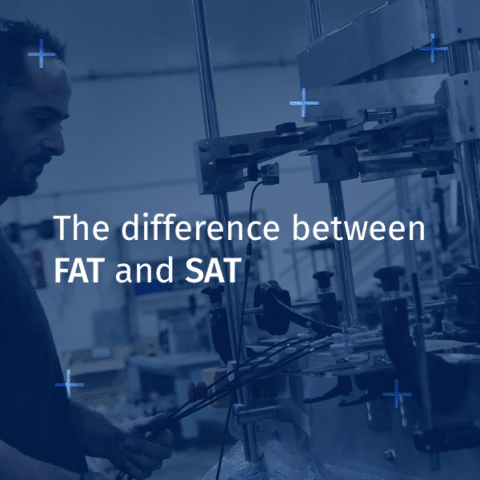When you invest in a new machine (such as a CDA monobloc), commissioning goes beyond simple installation. To ensure optimal operation of your equipment, it is advisable to carry out two control stages: the FAT (Factory Acceptance Test) and the SAT (Site Acceptance Test). CDA is equipped to guide you through the implementation of these protocols.
These two procedures, initiated by the machine operator, provide an additional guarantee that the machine meets technical specifications and operates perfectly in your production environment. It is essential for the manufacturer to understand the ins and outs in order to respond quickly and ensure compliance.
What is FAT (Factory Acceptance Test)?
The FAT is carried out at our facility before the machine (filler, capper, labeller, monobloc, or complete line) is shipped, with the client present. Numerous tests are performed to verify the machine’s proper functioning and conformity to the specifications agreed upon at the time of order. This process simulates near-real conditions (requiring many samples to run the machine for a defined period).
At CDA, your project manager and the production team that built the machine will assist you during the tests and verifications.
Main Objectives of FAT:
- Compliance with technical specifications: The FAT ensures that the machine meets the criteria defined at the time of order, not only in terms of speed and precision but also regarding key aspects such as safety controls, mechanical plan compliance, and electrical verifications. Mandatory documents, such as technical manuals, electrical, and pneumatic diagrams, are also validated.
- Functionality validation: FAT ensures the presence and proper operation of all functions outlined in the machine’s quote or specification sheet in all working modes: automatic, semi-automatic, and degraded. For example, if a marking detection function is required, the test confirms the sensor is installed, operates efficiently for all formats, and can only be deactivated by authorised personnel.
- Performance verification: The machine is tested in conditions closely simulating real production. For example, for a filler, the accuracy of the dosing and filling speed is checked. For a capper, torque control is verified, and for a labeller, the precision and speed of label application are tested.
Why is FAT important?
FAT allows the client to verify the machine’s components and validate compliance before shipment, reducing the risk of defects once installed at the client’s site. Identifying and correcting any issues before delivery ensures the machine is ready for seamless integration.
What is SAT (Site Acceptance Test)?
SAT is performed after the machine is installed at the client’s site, unlike FAT, which takes place at our facility. It serves as a final verification to ensure any necessary corrections identified during FAT are effective and that the machine operates correctly in its specific production environment.
It’s essential to note that our machines are built and adjusted in the controlled conditions of our workshops (temperature, pressure, humidity, lighting, etc.). When the machine is shipped to a laboratory or workshop in a different region or country where these conditions vary, some components may behave differently, requiring adjustments. These adjustments ensure the machine functions optimally in its new environment.
Main Objectives of SAT:
- Installation Qualification (IQ): IQ verifies that the equipment is installed in accordance with approved specifications and manufacturer recommendations. It checks the presence of required documents, compliance with “as-built” plans, and proper assembly of equipment. Electrical and pneumatic diagrams, along with materials used, must also be validated.
- Operational Qualification (OQ): OQ confirms that the equipment operates correctly within its intended functional range. It includes testing safety devices, user interfaces, and signals. Performance under normal and degraded conditions, as well as the accuracy of critical instruments, is verified before moving to the next stage.
- Performance Qualification (PQ): PQ verifies that the equipment consistently achieves the specified performance levels under real production conditions. It confirms that the final product meets quality requirements.
Why is SAT important?
SAT ensures that the machine operates correctly in its actual production environment. While FAT validates the machine’s functionality, SAT is critical to guarantee its seamless integration into the client’s production line.
FAT vs SAT: What Are the Major Differences?
| FAT (Factory Acceptance Test)
|
SAT (Site Acceptance Test) |
|---|---|
|
Conducted at the manufacturer’s facility
|
Conducted at the client’s site |
| Verifies technical specifications |
Verifies integration into the production environment
|
| Tests general functionality and performance |
Tests performance in real production conditions
|
| Validates the machine before shipment
|
Validates the machine in its final environment |
Conclusion
FAT and SAT are complementary steps in the integration process of your packaging machine, whether it’s a filler, capper, or labeller. FAT ensures that the machine is compliant and operational before shipment, while SAT ensures proper functioning on-site in real production conditions.
At CDA, we are committed to supporting our clients at every stage, from FAT to SAT, to ensure successful installation and optimal production. If you would like more information about our machines or our support during FAT/SAT, please feel free to contact us.






